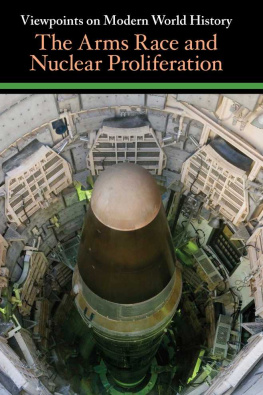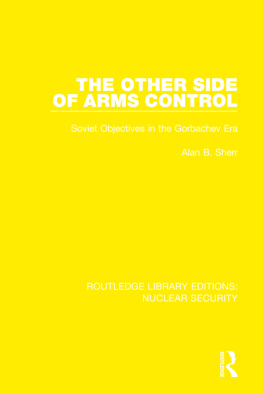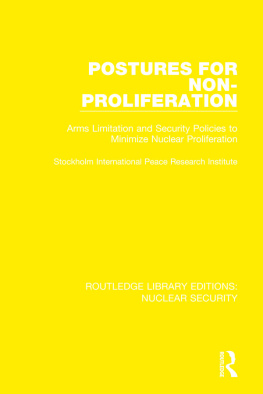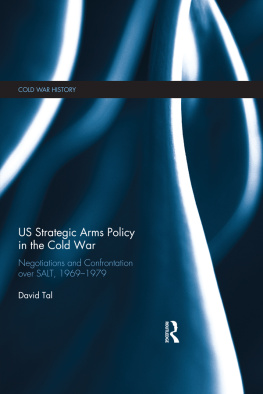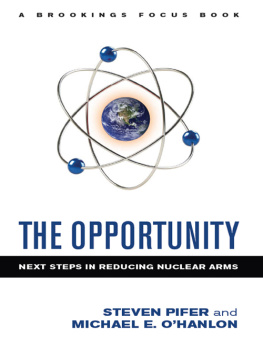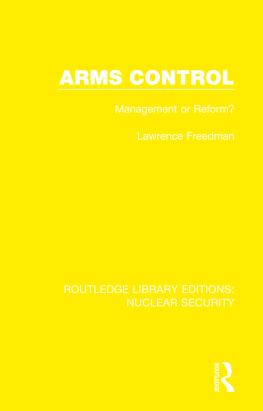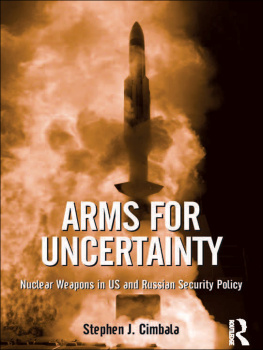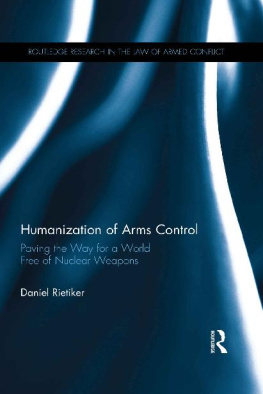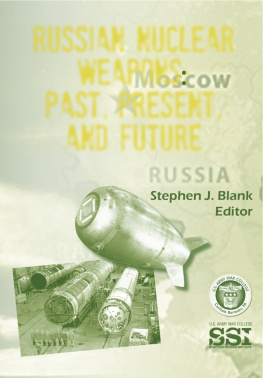First published in 1993 by
FRANK CASS & CO. LTD.
This edition published 2013 by Routledge
2 Park Square, Milton Park, Abingdon, Oxon OX14 4RN
711 Third Avenue, New York, NY 10017
Routledge is an imprint of the Taylor & Francis Group, an informa business
Copyright 1993 Frank Cass & Co. Ltd.
Library of Congress Cataloging-in-Publication Data Applied for.
British Library Cataloguing in Publication Data
Rethinking the Unthinkable:
New Directions for Nuclear Arms Control
I. Daalder, Ivo H. II. Terriff, Terry
327.1
ISBN 0-7146-4518-4
This group of studies first appeared in a special issue on Rethinking the Unthinkable: New Directions for Nuclear Arms Control in Arms Control: Contemporary Security Policy, Vol. 14, No. 1 (April 1993), published by Frank Cass & Co. Ltd.
All rights reserved. No part of this publication may be reproduced in any form or by any means, electronic, mechanical, photocopying, recording or otherwise, without the prior permission o f the publisher.
TERRY TERRIFF and IVO H. DAALDER
The signing of the START-II Treaty on 3 January 1993 heralded the end of an era. Since the late 1960s the United States and the former Soviet Union have engaged in a series of laborious arms control negotiations that, though establishing some useful parameters for the management of the strategic nuclear relationship, did little to lessen concerns about each others nuclear capabilities. Each feared that the other was seeking a strategic nuclear edge that could be exploited to its political, if not military, advantage. The main agenda of superpower arms control talks was to limit, and then reduce, the excessive build-up of strategic nuclear capacity and eliminate some of the more destabilizing components such as land-based ballistic missiles carrying multiple independently target-able warheads (MIRVs). But neither side trusted the other sufficiently to agree to limitations that would accomplish the goals of this agenda. As a consequence, the arms control agreements that the two nuclear superpowers were able to conclude only marginally eased strategic concerns and political tensions.
START II at last represents success. The United States and Russia have agreed to reduce their strategic nuclear arsenals by about two-thirds, from current levels of around 11,00012,000 warheads to about 3,0003,500 by 2003 at the latest. Perhaps most significant is that the agreement achieves the vital goal of eliminating MIRVed land-based missiles, long regarded as the most threatening and destabilizing component of the respective nuclear arsenals. But START II leaves some important issues unresolved, since it includes no requirements for the dismantlement of warheads, the verification of such dismantlement or the placement of fissile material under safeguards. The implementation of the treaty also is not yet assured, for this depends, first, on Ukraine ratifying the START-I Treaty and, second, on overcoming the considerable opposition to START II that exists in Russia. Nonetheless, once implemented, the START-II Treaty will complete at least the main elements of the superpower arms control agenda of the past quarter century.
The sweeping and deep reductions of START II were made possible by the end of the Cold War, which has brought a profound transformation of the relations between the United States and the former Soviet Union. The political and strategic hostility and competition that characterized much of the Cold War has abated and been replaced by tractable and even co-operative behaviour. This climate is conducive to radical arms control, as represented by the deep cuts of START II. Washington no longer perceives the independent states of the former Soviet Union as much of a threat to the United States and its Western allies, and Moscow sees the West not as a source of threat but of political and economic assistance. With the relaxation of tensions, the United States and Russia have recognized that mutual security can be best achieved not through antagonism and competition but through mutual restraint and co-operation. Thus, in providing the coda to a generation of arms control efforts, START II has codified the end of the Cold War.
But does the successful conclusion of the START series of negotiations, and the arms control agenda they represented, mean the end of nuclear arms control? The political and strategic environment in which the superpowers pursued their nuclear competition and arms control negotiations no longer exists. New political and strategic realities are emerging. The end of the Cold War and the concomitant political and strategic transformation of the international system opens up new opportunities and brings new dangers. Amongst the dangers is the threat posed by the spread of ballistic missile and nuclear weapons technology. Amongst the opportunities is the possibility of further US-Russian co-operation in nuclear arms control efforts, both to reduce still further their respective arsenals and to strengthen the norm of nuclear non-proliferation. The changing nature of the US-Russian relationship and the international environment raise some fundamental questions about the future of nuclear arms control:
What are the long-term objectives of nuclear arms control?
Should further reductions beyond START II be made in the nuclear arsenals of the United States and Russia?
Does nuclear arms control have other roles to play in the US-Russian nuclear relationship?
Should nuclear arms control be extended to include the United Kingdom, France and the Peoples Republic of China?
How do we manage the promise and problem of strategic defences?
How do we manage the spread of ballistic missiles and nuclear weapons?
Are there new ways of conceptualizing and addressing the problems posed by nuclear weapons?
In 1992 the Center for International and Security Studies at Maryland (CISSM), supported by a grant from the W. Alton Jones Foundation, initiated the Project on Rethinking Arms Control. The aim of the project is to foster the reconceptualization of arms control in a manner that makes it more relevant to present day realities. The project has sponsored the presentation of papers presenting new and provocative proposals for the future direction of arms control at workshops attended by policy analysts, journalists, leading academics, and US government officials. Several of these presentations dealt with nuclear arms control. These have been revised and updated, and are published in this special issue of Arms Control. They include the contributions by Michael Brown, Ivo Daalder, William Durch, Lisbeth Gronlund, John Hawes, Lora Lumpe, and George Quester. Further articles exploring provocative or alternative approaches to nuclear arms control have been contributed by Alexei Arbatov, Michael Clarke, and Jonathan Dean.


